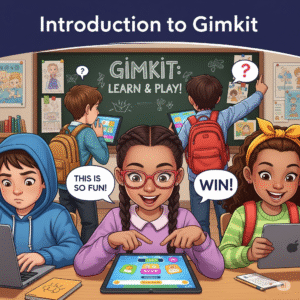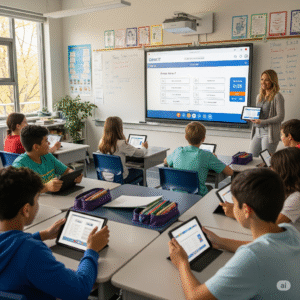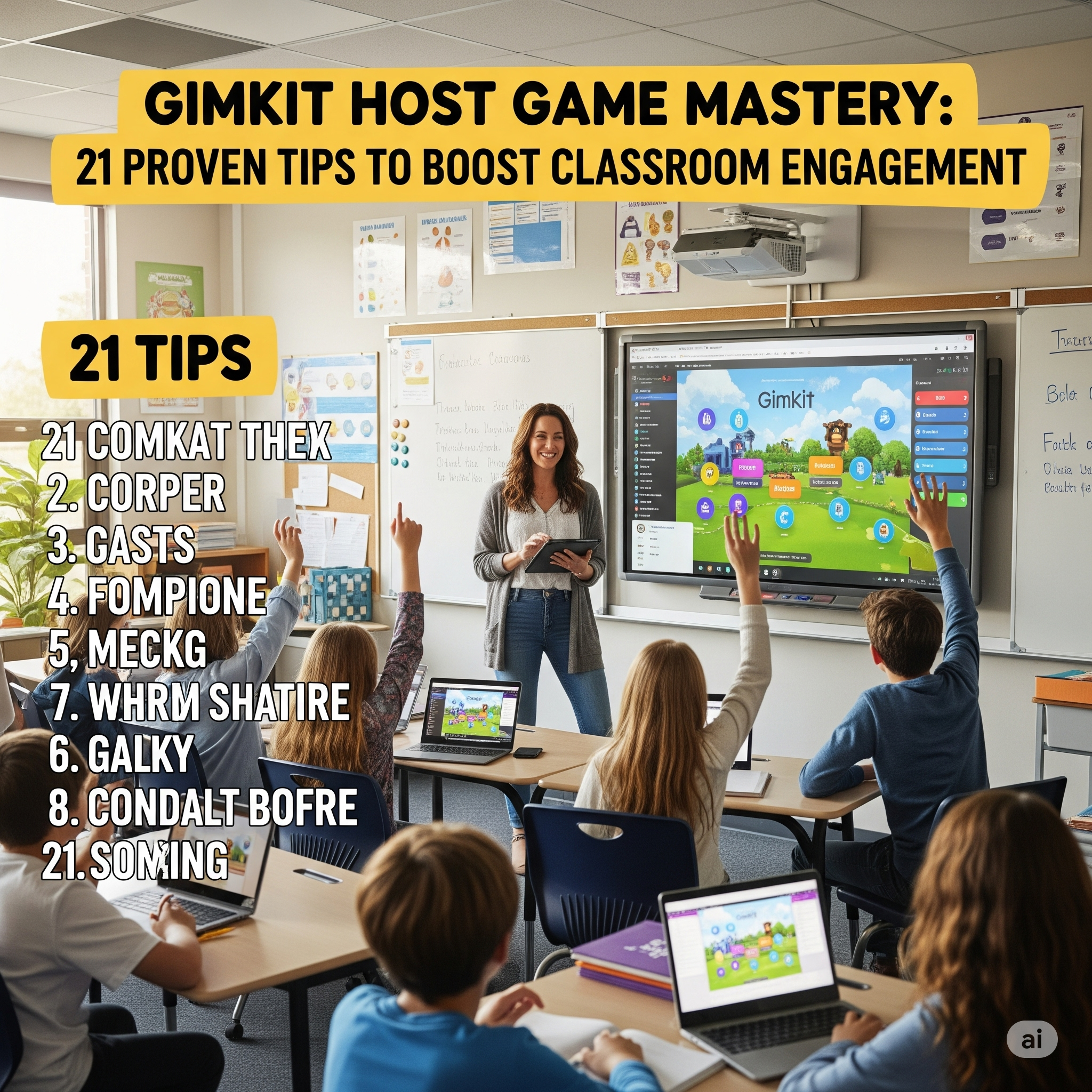Introduction to gimkit

Gimkit is a dynamic teaching platform that allows teachers to do lessons and quizzes in real time. Whether you are in a traditional class or distant learning environment, it helps in converting passive learning into active participation.
Developed by a high school student, Gimkit allows teachers to create educational games, share, and host, where students answer questions to earn virtual cash, buy upgrades, and win the game.
With its immersive format and educational value, Gimkit-hosted game sessions are becoming a favorite among teachers worldwide.
What does it mean to host a game in Gimkit?

Hosting a game in Gimkit is to launch a live or assigned session using a (or imported) question set you created. You act as a facilitator, start gameplays, customize the settings, and through the session guide students through either synchronous (live) or asynchronous (assignment) activities.
During a hosted game, students are involved using the game code or link. As they answer questions, they submit digits or “gimkit cash” based on the correct reactions, speed, and strategy. The host monitors progress, adjusts settings, and uses post-game collected insights to improve learning results.
Why Educators Love Hosting Gimkit Games

Educators across grade levels enjoy hosting Gimkit games due to:
-
Increased student engagement
-
Immediate feedback and data reports
-
Variety of game modes (Team, Classic, Trust No One, etc.)
-
Flexibility for remote and in-person learning
-
Easy integration with Google Classroom and other tools
Gimkit doesn’t just make learning more fun—it makes it more effective.
How to Set Up Your First Gimkit Game
Step-by-Step Game Hosting Guide
-
Create a Free Account at Gimkit
-
Click on “New Kit” and add your questions manually or import via Quizlet, Excel, or CSV.
-
Choose your preferred game mode (Classic, Trust No One, Team Mode, etc.)
-
Adjust game settings:
- Time limit
- Starting cash
- Power-ups
-
Click “Continue” to generate a game code.
-
Share the game code with students.
-
Click “Start Game” to begin!
Recommended Game Modes for Engagement
| Game Mode | Best For | Key Feature |
|---|---|---|
| Classic | Solo learning | Individual competition |
| Teams | Collaboration | Group-based play |
| Trust No One | Review + Fun | Among Us-style deduction |
| Infinity Mode | Mastery | No time limit, unlimited questions |
| Boss Battle | Class vs. AI | Encourages teamwork |
21 Expert Tips to host an unforgettable gimkit game
1. Learn your objectives
Decide that the game will strengthen learning, assess understanding, or simply serve as an icebreaker.
2. Choose the right game mode
Select a game mode that fits your learning goal. “Trust No One” is great for review days, while “classic” works well for quizzes.
3. Customize game settings
Adjust the time, power-up frequency, and correct answer per time to keep the gameplay balanced.
4. Use quality questions
Avoid questions that are very easy or very difficult. Clear, deliberate questions promote real engagement.
5. Give your game strategically
Initially use gimkit at the end of the classroom for warm-ups or as reinforcement.
6. Add music or sound effects
Use classroom-safe background music to create a game-show environment.
7. Enable power-up smartly
Use earnings to buy power-ups for students that give them an edge in sports.
8. Keep it competitive
Display leaderboards from time to time to fuel motivation.
9. Use teams for cooperation
The group play team encourages work and peer learning.
10. Offer real-world awards.
Awards for top artists include homework passes, stickers, or class privileges.
11. Review questions after the game
To clarify the misunderstanding, go to any missing question.
12. Host surprise rounds
Unannounced sports increase enthusiasm and vigilance.
13. Encourage reflection
Ask the students whether the strategies worked or what not.
14. Use assignment facility
Host asynchronous games for homework or amendment.
15. Track the student progress
Use built-in analytics to monitor the performance.
16. Include students in sports building
Let students suggest questions for the next game.
17. Include weekly challenges
Create a leaderboard that resets weekly for ongoing inspiration.
18. Use it for formative assessment
Quickly identify knowledge intervals without formal tests.
19. Analyze the report after each game
Gimkit gives detailed insight into who answered what, when, and how.
20. Student respond
Some types of words post-game go a long way.
21. Have fun and use
Try different modes and see what your class has the most enjoyment with!
Hosting a Gimkit Game Remotely vs. In-Person
Key Differences
While the core gameplay remains the same, hosting a Gimkit host game remotely versus in-person comes with some important distinctions.
| Factor | In-Person | Remote |
|---|---|---|
| Interaction | Real-time physical engagement | Chat-based or voice/video instructions |
| Supervision | Easier to monitor screen time and focus | Requires trust and periodic check-ins |
| Energy | Higher excitement in live classroom setting | May need icebreakers or hype to build momentum |
| Tech Support | Easy to troubleshoot issues in real time | Must anticipate potential tech issues ahead of time |
Best Practices for Both Formats
-
Use breakout rooms for team modes during remote sessions.
-
Project the leaderboard live in classrooms or share the screen on Zoom/Meet.
-
Provide clear instructions before starting the game.
-
Test tech setups beforehand to avoid delays.
-
Encourage webcam/mic use in remote settings for greater engagement.
Common mistakes while hosting Gimkit Games
Avoiding common losses ensures a smoother, more impressive experience for students.
A lot of power-up-fit use can make the game chaotic and inappropriate.
- Poorly written questions—misleading or vague questions disappoint students.
- There is no post-game review, missing the chance to strengthen the points of looking.
- Ignoring the dynamics of the team—unbalanced teams can ruin the game.
- Not preparing students—introduce sports and rules before always starting.
- Gold is for tracking progress to the report by reducing the report.
Hosting without a purpose—the game must align with educational goals, not just to fill the time.
About 6 FAQs about hosting a gimkit game
1. Is it free to use Gimkit?
Yes, Gimkit offers a free version with basic features. However, Gimkit Pro unlocks advanced game modes, assignments, and deep analytics.
2. Can I assign Gimkit games for homework?
Absolutely. Use the “assignment” option instead of live hosting so that students can complete it as they persevere.
3. Which age group is it suitable for?
Gimkit is ideal for grades 3 through 12 but can be adapted to college-level learners with appropriate question sets.
4. How long should a gimkit game last?
It is optimal anywhere for 5 to 20 minutes. Going for a very long time can cause fatigue.
5. Can I import questions from other platforms?
Yes. You can import from Quizlet, a spreadsheet (CSV), or manually type within the GIMKIT interface.
6. Do students need accounts to play?
No. Students only require a game code to join the live game. Accounts are optional until they are assigned to the game as an existential game.
Conclusions: Make learning with gimkit fun and effective
The host of Gimkit host game is not just about playing a digital quiz—it’s about how your students engage with learning.
From promoting participation and retention to promoting teamwork and fun, Gimkit has proved to be a powerful edtech tool in both traditional and virtual classes.
21 expert tips: avoid general mistakes and tailor your hosting approach to your specific classroom needs. You can make every sports session more academic, pleasant, and unforgettable.
So, whether you are new to gimkit or an experienced user, dive in and search for your students the joy of interactive learning!
